Michigan hop scouting report for May 26, 2015
Frost and freeze weather events set hop bines back in some Michigan locations last week. Most varieties tolerate frost well and undamaged bines have continued to expand.

Northwest Michigan summary
Last week some hop production areas experienced frost and freeze conditions, with large areas in the north experiencing temperatures in the mid-20s and up to eight hours below freezing. Symptoms of damage began with tip death and bines unwinding from the string. During the days following the damage, symptoms have become more obvious as hop tissue becomes necrotic in some of the hardest hit locations. Hop yards in areas experiencing less intense cold and frosts may see some bronzing between leaf veins or necrotic leaf margins as the only symptoms – damage may be more intense on newly emerged and delicate leaves. Hop plants, particularly well-established crowns, typically bounce back from frost and even freeze injury if trained bines got nipped; growers may retrain unaffected emerging bines in their place.
Not sure if you had a frost or a freeze? You can look up the "hours below freezing" at your nearest Michigan State University Enviro-weather station and read about frost versus freeze damage in the article “What is the difference between a frost and a freeze?” by Michigan State University Extension.
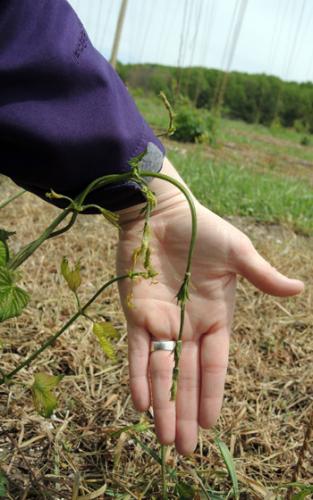
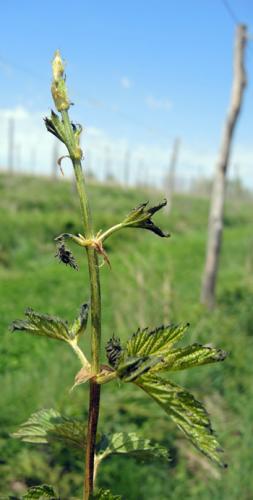
Left, Hop bine with tip die-back that is falling off the string, caused by freeze damage. Right, Necrotic leaf tissue caused by frost.
Hop bines are really taking off with the ample rain and some warmer weather. Bines vary in height, but average 4 feet in northwest Michigan yards that were not mowed this spring. Active downy mildew infections have been observed in the north.
Southwest Michigan summary
During last week’s cold night, May 19-20, overnight lows in southwest Michigan were only below freezing in a few areas and only for a short time. It appears hops bines in our area were not injured by this event. Various symptoms of downy mildew have begun to appear, as well as potato leafhoppers coming in on storm fronts. Growers should scout for damage from two-spotted spider mites.
Hopyards in the southwest have mostly been strung and vary greatly in height by management practice and plant age, up to several feet or more. For those that haven’t begun irrigating yet, recall that water demand from the hop plants is ramping up as shoot growth accelerates.
Statewide report
Growing degree day (GDD) accumulation is significantly different along the western portion of the state where the majority of hop acreage is located. So far this season, the Benton Harbor Enviro-weather station has accumulated 392 GDD50 with 0.14 inches of rain over the past week, the Clarksville Enviro-weather station has recorded 343 GDD50 with 0.2 inches of rain, and the Northwest Michigan Horticultural Research Center accumulated 250 GDD50 with just under 2.0 inches of rain this past week. These GDD accumulations are substantially behind last year’s. Some planting and stringing is still underway and some growers have yet to turn on their irrigation systems. Training has begun around the state and will continue.
After seeing significant downy mildew infection in 2014, many growers have been proactive in applying protectant early sprays as basal spikes emerged this spring. The second phase of the pathogen’s life cycle has begun; this phase represents the period of time when disease can be readily spread between plants and warrants continued protectant fungicide applications. If you already have downy mildew established in your hopyard, cultural practices will be very important in regaining ground as the season progresses.
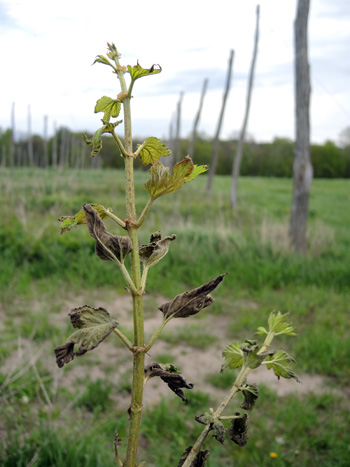

Systemically infected downy mildew infected hop “spike,” with secondary gray-black sporulation occurring on the underside of leaves.
According to Oregon State University, diseased shoots on the string should be removed by hand and healthy shoots retrained in their place. Remove superfluous basal foliage and lower leaves to promote air movement in the canopy and reduce the duration of wetting periods. If there is a cover crop, it should be mowed close to the ground. If yards have no cover crop, cultivation can help dry the soil and minimize humidity. Keep nitrogen applications moderate. For more information on downy mildew management, refer to “Managing hop downy mildew early in the season is critical” by MSU Extension.
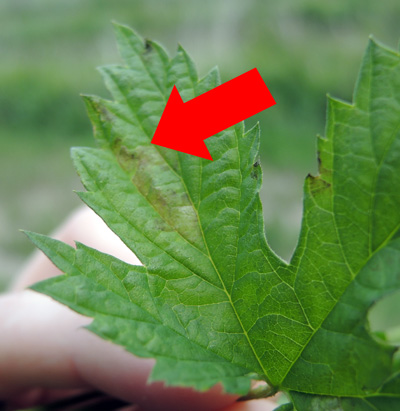
New lesions visible as slightly chlorotic, angular section on leaves.
With significant leaf tissue present, many growers have begun scouting for mites. Twospotted spider mites (TSSM) are a significant pest of hops in Michigan and can cause complete economic crop loss when high numbers occur in two ways:
- Decreasing the photosynthetic ability of the leaves.
- Causing direct mechanical damage to the hop cones.
TSSM feed on the liquid in plant cells, eventually causing visible symptoms. Leaves take on a white appearance and will eventually defoliate under high pressure conditions. Intense infestations weaken the plant and reduce yield and quality. Infested cones develop a reddish discoloration, do not hold up to the drying process and commonly have lower alpha levels and shorter storage potential. Additionally, the mites themselves act as a contaminate issue for brewers.
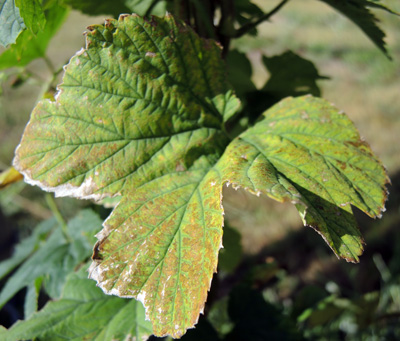
Damage to hop leaves caused by twospotted spider mite feeding.
In the spring, only female TSSM are present. After they mate, females overwinter in a dormant stage on debris and trellis structures. They emerge in the spring already mated and ready to lay fertilized eggs, often appearing particularly orange in color this time of year. As the temperature warms, the females feed and begin laying eggs. Larvae emerge from the eggs in two to five days, depending on temperature, and develop into adults in one to three weeks, again depending on temperature. TSSM like it hot with the pace of development increasing until an upper threshold around 100 degrees Fahrenheit is reached. Conversely, cold and wet weather slows down their development.
TSSM are very small but can be observed on the underside of leaves using a hand lens. As the season progresses, cast skins and old webbing give infested leaves a dusty and dirty appearance. The eggs look like tiny, clear spheres and are most commonly found in close proximity to adults and larvae. The larvae themselves are small, translucent versions of the adults which begin the season with a distinctly orange hue that changes over to translucent, yellow or green as they feed. Adults also have two distinctive dark spots, hence the name. When you are observing the underside of leaves, keep an eye out for beneficial predatory mites that actually feed on TSSM. Predatory mites are often translucent, larger than TSSM and move at a much faster speed across the leaf surface. Predatory mites play an important role in balancing the TSSM population and should be protected when possible by avoiding the use of broad spectrum insecticides. Refer to pages 11-12 of “Pesticides registered for use on hop in Michigan 2015” for more information about impacts of pesticides on beneficial mites.

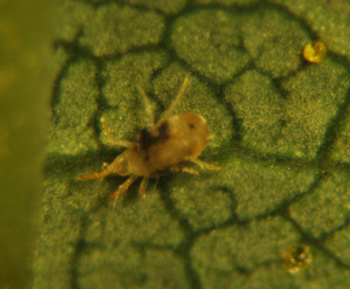
Twospotted spider mites as seen with the naked eye and under magnification. Note the sand and cast skins collecting on the webbing associated with the mites, giving the leaves a dusty appearance.
Growers should be scouting for mites now and remember that only when mites reach an economically significant level should cultural and chemical intervention be considered. Scouts should take leaf samples from all portions of the bines. Use a hand lens to evaluate two leaves from 20 plants per yard. Thresholds developed in the Pacific Northwest have established that more than two adult mites per leaf in June indicates the need to implement a pest management strategy. By mid-July, the threshold increases to five to 10 mites per leaf. Remember that if cones are not infested, hop plants can tolerate a good deal of damage from mites.
There are many factors that can affect the prevalence of mites in a given season, including the presence of beneficials, rainfall and temperatures. Consider selecting insecticides that have a minimal effect on beneficial insect populations and do not apply pesticides for mite control unless absolutely necessary. The reason for this is that one application will damage beneficial predators, and in their absence repeated applications will be necessary. Specifically, pyrethroid pesticides (IRAC group 3A) have been shown to increase pest mite populations in the hopyard due to their negative impact on predator mites.
Lastly, growers should also be on the lookout for potato leafhoppers (PLH) this week as storm systems move through, likely carrying adults from the Gulf Region. So far this season, PLH have only been observed in central and southern Michigan hopyards. Potato leafhoppers move in all directions when disturbed, unlike some leafhoppers that have a distinct pattern of movement. Adults and nymphs appear a fluorescent green color. Some very small nymphs are actually clear, but have the characteristic shape of the larger nymphs when viewed using a hand lens.
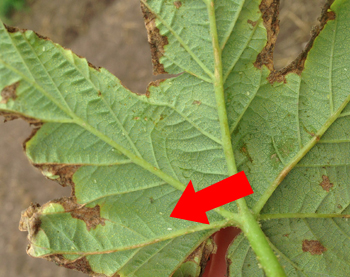
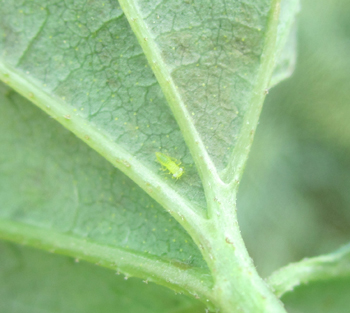
Left, multiple potato leafhopper nymphs and adults on the underside of a hop leaf exhibiting necrotic “hopper burn” symptoms around the leaf margin. Right, potato leafhopper nymph under magnification.
Although hop plants are susceptible to PLH, they can tolerate some level of feeding, and growers should be conservative in insecticide applications. PLH causes what growers have termed “hopper burn,” which causes necrosis of the leaf margin in a V-shaped pattern and may cause a yellowed or stunted appearance as well. When hops bines are shaken quickly, adults will take flight. Growers can go through and shake bines and look for flying adults as a quick spot check. Confirm their presence by flipping leaves over and looking for adults and wingless nymphs on the undersides.
Growers needing to treat for PLH can utilize labeled products containing neonicotinoids (IRAC group 4A, e.g., thiamethoxam and imidacloprid), pyrethroids (e.g., beta-cyfluthrin, bifenthrin and pyrethrin), organophosphates (group 1B, e.g., malathion), tetramic acid derivatives (group 23, e.g., spirotetramat) or spinosyns (group 5, e.g., spinosad). Organic growers can utilize spinosad or pyrethrin formulations that are OMRI-approved for PLH management. For a complete list of registered products and the chemical class to which they belong, refer to “Pesticides registered for use on hop in Michigan 2015.” Refer to pages 11-12 to determine which products will have the least negative impact on important beneficial insects like predatory mites.



 Print
Print Email
Email



